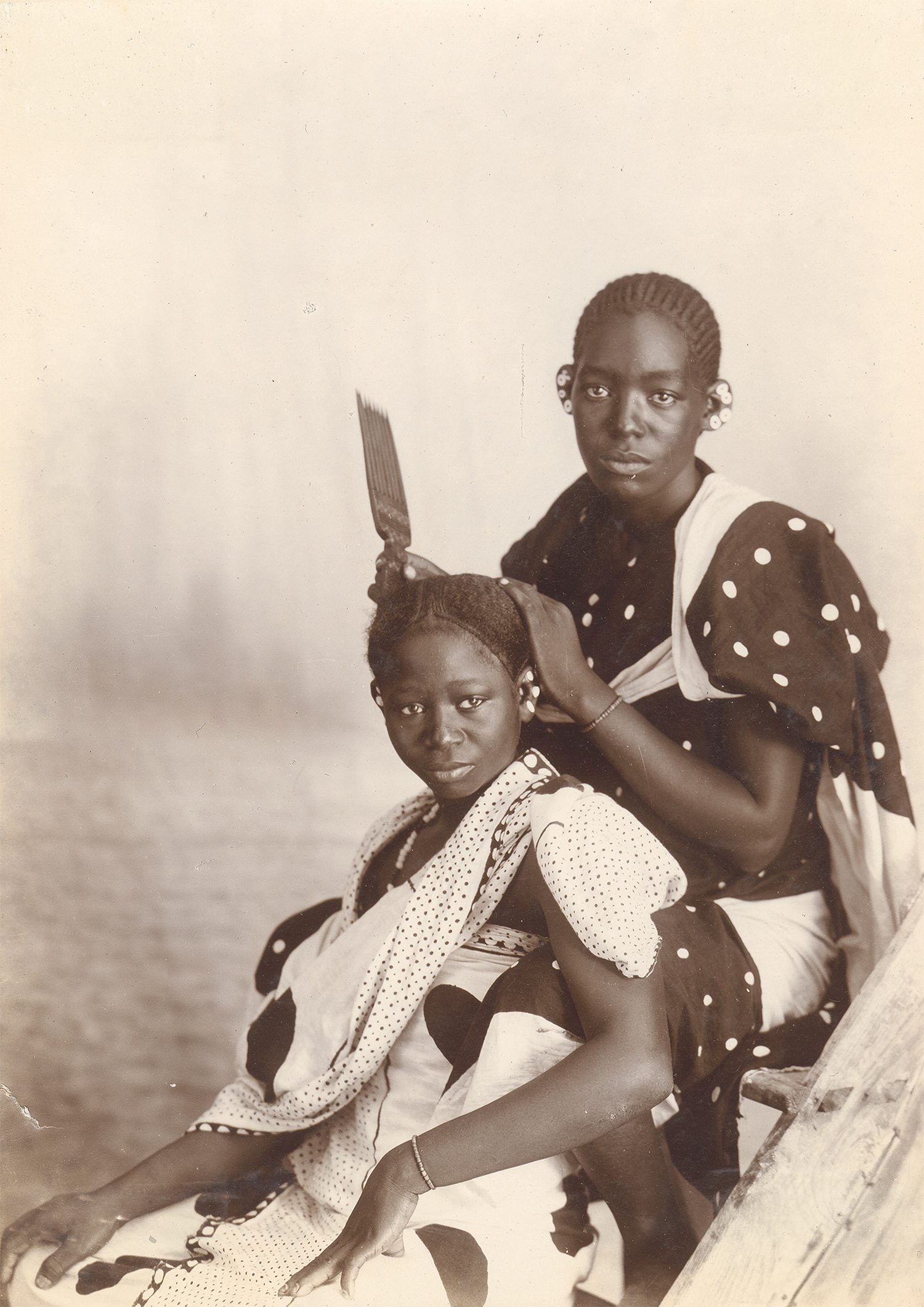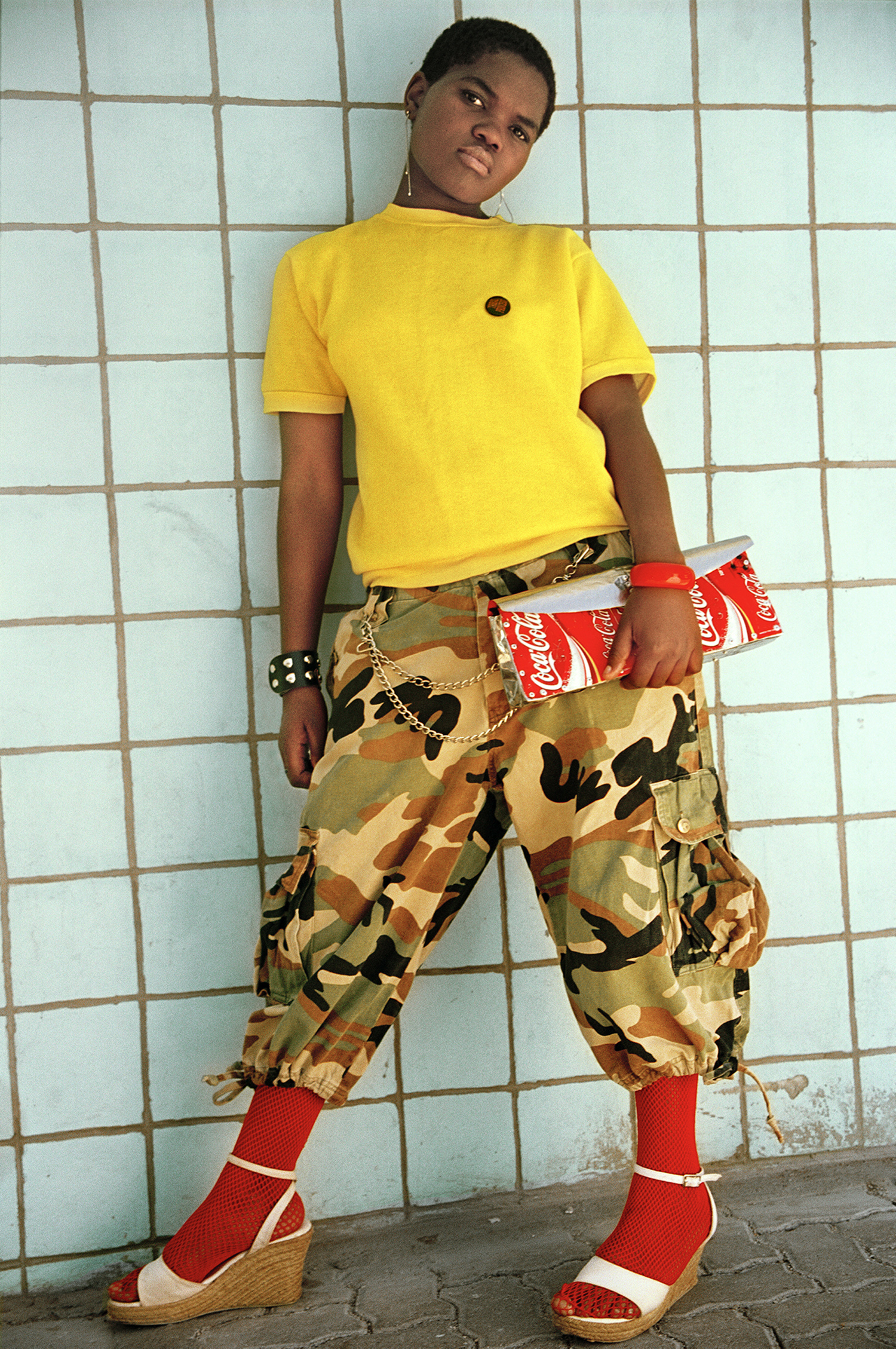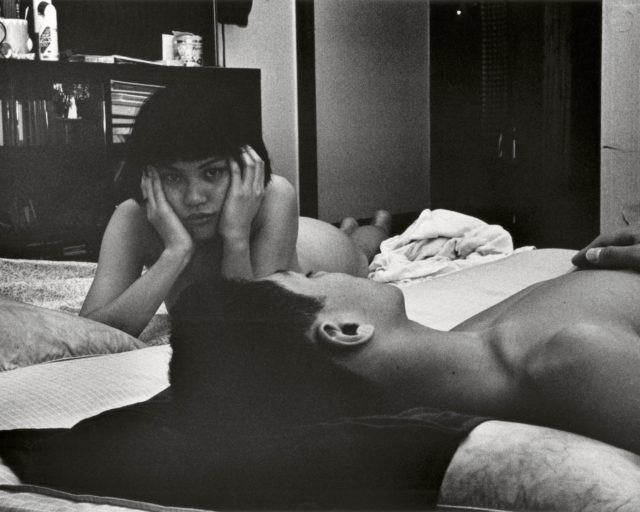Revisiting African Portraiture, Through the Female Gaze
Sandrine Colard and Laurence Butet-Roch examine the history of how African women have been pictured, and in turn, how they look back at the viewer.
A double entendre is at the heart of Sandrine Colard’s latest curatorial achievement, the exhibition The Way She Looks: A History of Female Gazes in African Portraiture, recently on display at the Ryerson Image Centre in Toronto. The title can indeed be interpreted in two ways. Immediately, it speaks to how a woman appears to us, the spectators, in an image; what we can infer from her style, her posture, her expression. Such a reading brings forth the responsibility we have, as members of the public, in interpreting these different cues to (re)construct the identity of the sitter, and to imagine the conditions of the photographic encounter. Yet moving through the three sequential sections of the show—“The Birth of a Gaze,” which covers colonial representations during the nineteenth and early twentieth centuries; “The Visual Soliloquy,” which focuses on the studio work of celebrated mid-century African artists, such as Malick Sidibé, Seydou Keïta, and J.D. ‘Okhai Ojeikere; and “Self-Possessed,” which highlights the different themes that contemporary photographers on the continent explore through portraiture—another understanding emerges. It is not only the way that the women look to us, but also the way they look at us, at the photographer, and what this gaze conveys. Colard explained to me exactly how this expanded understanding of the female gaze reframes the history of the medium.

A. C. Gomes & Sons, Natives [sic] Hair Dressing, Zanzibar, Tanzania, late 19th century
Courtesy The Walther Collection and Stevenson, Cape Town and Johannesburg
Sandrine Colard: Looking back at the role of art, including photography, in depicting African women and women of African descent is very tied to the arrival of new curators from these very communities. In the last year, there was the exhibition Aunty! African Women in the Frame, 1870 to the Present at United Photo Industries Gallery in Brooklyn, cocurated by Laylah Amatullah Barrayn and Catherine E. McKinley—which showed a selection of images from McKinley’s collection and centered African women—as well as Posing Modernity: The Black Model from Manet and Matisse to Today, based on Denise Murrell’s dissertation, which started at the Wallach Art Gallery at Columbia University and traveled to the Musée d’Orsay in Paris. These exhibitions, which present a different view of photographic and art history, exist because the profession is changing thanks to the diverse profiles of new curators.
And, in regards to The Way She Looks, it harks back to when I was doing my PhD in art history at Columbia University. Each time there was a discussion about a Black character in art, especially a Black female character, it always revolved around issues related to the body and its exploitation. I’m a Black woman, and most of my peers and myself don’t think of ourselves as only that, a body. When we consider this disconnect, this show is both overdue and obvious. While the question of the body remains relevant, there’s room for another history of Black women, where we see that they had (and have), even in difficult circumstances, the power of shaping the way they want to be seen.
Butet-Roch: Your notion of the female gaze includes women photographers’ visions, but also the gaze that female sitters return to the photographer. What can be learned from paying attention to the gaze of the sitters?
Colard: When you look at colonial images of African subjects from the late nineteenth, early twentieth centuries, only one woman is named; the rest are labeled according to their ethnographic “type.” Yet if you were to ignore the captions, and when you really look at these people—not just glance—the range of expressions and gazes is a testament to their humanity, and it completely defeats the caption that tries to reduce them to a type. In fact, it ridicules the caption. Take the image by Alfred Martin Duggan-Cronin entitled Bakgatla: when you look at how this woman poses, you see that there’s a lot more to her than what the caption suggests. Of course, since we were not there and we have no account of the photo session, we’ll never know exactly how the photographic transaction went. What we do know is that the photographer was undertaking the ambitious project The Bantu Tribes of South Africa, which was conceived as an encyclopedia of ethnographic “types” and “primitive” people. Many of his photographs don’t match the anthropographic aesthetic of the time. Maybe it was because the photographer deliberately strayed away from it, or, more likely, because the women he encountered, via their gaze, refused to be reduced and encapsulated by a type.

Alfred Martin Duggan-Cronin, Bakgatla, South Africa, early to mid 20th century
Courtesy The Walther Collection, Stevenson, Cape Town and Johannesburg, and The McGregor Museum, Kimberley
Butet-Roch: Beyond revealing the complexity of the relationship between the photographer and the sitter, how do these gazes involve the viewer and interrogate the act of looking?
Colard: I really love Ariella Azoulay’s concept of the responsibility that we have toward the images, even one hundred years later. When all the images were hung on the wall, I was deeply moved, because I felt that they were looking back to ask for meaningful engagement from the viewer. I’m a strong believer that we have a responsibility to the subject, not only when we’re the photographer taking the picture, but also in regard to how we use the photos afterwards, how we present them, how we frame them, and the discourse that we build around them. I’ve had a sense that in the last few decades, we have attributed so much power to the colonial gaze. We read images from Africa through that lens only, to the point that we became blind to anything else the subject within the image was expressing.
Bearing this in mind, it was very important for me to include a historical perspective in the exhibition, because so often, when we discuss the great contemporary photographers—such as Zanele Muholi, Joana Choumali, or Aida Muluneh—they are presented as if they came out of a vacuum, that there was nothing before them. Such a timeline is not doing justice to the agency of the sitter, nor to the work of some of these artists’ predecessors. Only very recently was the photographer Felicia Abban recognized in the Western Hemisphere. She was a portraitist who had her own studio in Accra, Ghana, from the 1950s on. This changes everything, and I’m sure that more research will demonstrate that she was not the only one.
Butet-Roch: How can that expanded notion of the female gaze disrupt our understanding of the role of women in photography, on the one hand, but also our perception of African women as “powerless” in their representation?
Colard: It actually also tells us a lot about the art world. Take for instance how Seydou Keïta has become this icon and darling of the art world in the West. For the longest time, he was considered an artisan, that is until he was adopted by the art world of the West and became an artist. Yet, when subjects were stepping inside his studio, they were as much of an author as he was. They picked him to photograph them, they often chose and created the clothes they were going to wear, they brought the person with whom they wanted to be seen, and so on. Take the image of the two women that came dressed in the same way; the patterns and textiles are not trademarks of Seydou Keïta, but rather an expression of the sitters’ bonds of friendship, kinship, and solidarity. You can see this agency of the subject in the work of another African portrait photographer, Malick Sidibé. These observations contradict the Western art discourse, which tries to package him as this author who was in total control of everything he was portraying.
Butet-Roch: Why is it important to prioritize the agency of the sitter?
Colard: When we don’t recognize people, it’s very dehumanizing. Last year, the book Sexe, Race et Colonies was released. It’s a collective work featuring the analysis of respected French historians on the visual sexual exploitation of non-Western women in the French colonies. Despite its good intentions, this book insulted me. The cover of this beau-livre featured the title in neon, referencing brothels. More importantly, the texts further victimized the women photographed by failing to recognize the power they had, thereby reinforcing the stereotype of African women as powerless.

Nontsikelelo “Lolo” Veleko, Nonkululeko, from the series Beauty is in the Eye of the Beholder, 2003
Courtesy the artist and Goodman Gallery, Johannesburg
Butet-Roch: Speaking mainly about the colonial archive component of this show, you wrote for the wall text accompanying the exhibition that it promises to bear witness “to the emergence of an African female photographic gaze and subjectivity without ignoring or erasing the harmful objectifications of the past.” This rings true for the rest of the show as well. How did you balance these two objectives—especially given that you did not want to continue giving critical attention to works that have subjugated African women—in the colonial archive section, but also in the modern and contemporary sections?
Colard: I was very intentional in my selection, looking for images that geared toward this visual exploitation of the female body, but that also provide room for further reflection. In one corner of the exhibition room, there’s an image of an odalisque-like woman. She’s paired with an image of a woman who returns a very oppositional gaze, thereby suggesting the spectrum of responses to being photographed that existed in the nineteenth century. You had all kinds of situations in the studios, from consent to coercion. I’m dedicated to demonstrating that even in the sometimes small area in which these women could express themselves, they used varied expressions to convey how they felt about the situation.
Butet-Roch: The concept of dignity reverberates throughout the exhibition. You mention it in reference to Guy Tilim’s work where the “‘subjects’ dignified bearing diverges from the norms of humanitarian ‘crisis’ photography,” as well as in relation to an 1870s portrait by Barnard that presents his sitter in the formal setting usually afforded to European subjects.
Colard: Let’s start with Guy Tilim. I hesitated about including the image Fiorinda Ngoma, Her Mother Rosalia Nahamba (Holding Baby Filomena Lasinda) and Her Sister Rosali Sindali, Holding Baby Guerra (2002) until I read the 2014 article “One hundred years of suffering? ‘Humanitarian crisis photography’ and self-representation in the Democratic Republic of the Congo” by Aubrey Graham. The article touches on photojournalists in warzones and how they sometimes perpetuate the very things they think they’re denouncing. The article was written from the standpoint of the subjects. The author notes how in certain images, the women changed the way they posed if they were in front of a foreign war photographer. In that choice—deciding to pose in a certain way—there’s agency, and therefore, dignity. In this case, the young woman in the foreground brings her hand to her face, which historically, within her culture, signifies sorrow. Even if this image presents her as a victim, which in some respect she is, she also made a choice of expressing that in the way that she wanted.

Samuel Baylis Barnard, Bushwoman [sic] and Children, South Africa (Portrait of !Kweiten ta //ken), 1874–1875,
Courtesy The Walther Collection and Stevenson, Cape Town and Johannesburg
Colard: In this image, the woman, whose name is !kweiten ta ||ken, is not represented in the usual anthropological codes of the time, but rather according to European codes, which make her appear “dignified.” However, what I think is interesting is that it makes us reflect on how the anthropological portrait is intended to entirely dissolve the subject. The subjects are never named, so they’re not commemorated, nor even presented as individuals. They’re a type. Sometimes, the more you are imaged, the less visible you become. Images of Africans at the turn of the nineteenth century were primitivizing in order to justify the presence of the colonizer as a “civilizing” force. Yet, this image by Samuel Baylis Barnard is valorizing her aesthetically, and the fact that the caption includes her name is very charged with meaning. When you are represented as a nameless “type,” you are generalized, and in fact, you are undergoing the exact opposite of a portrait session, which seeks to seize you and no one else. Naming her is individualizing her, recognizing her uniqueness, and therefore making her the opposite of a type.
Butet-Roch: Perhaps because I read it recently, I had the following quote by bell hooks in mind when going through the exhibition: “Understanding marginality as position and place of resistance is crucial for oppressed, exploited, colonized people. If we only view the margin as sign marking the despair, a deep nihilism penetrates in a destructive way the very ground of our being.” The photographs produced by African artists from the later part of the twentieth century until now seem to heed to that call in a variety of ways. Could you speak to that?
Colard: This quote reminds me of Frederick Douglass and the double consciousness. The “benefit” of being part of a marginalized or minority community is that you always have double insights into the world around you. Even though it’s painful, this position is an extremely rich one, as we can see in the works of many contemporary artists who are using the genre of portraiture to talk about more than simply the representation and interpretation of the body. Imagine if, as a Black woman artist, I was only allowed to talk about the body. That’d be extremely restrictive. Hence, it was important for me to show the diversity of what they could do with the portrait genre, how it could be used to talk about issues that concerned them. For example, Mimi Cherono Ng’ok talks about homecoming, the uncanny, and what it is like to look at your family members as strangers when you come back from somewhere else.
Butet-Roch: Mikhael Subotzky once recounted how he and Thabiso Sekgala discussed what makes a good portrait work. He said that they both felt that it was the “duality of the subject being both present and distant” that is “engaged with the photographer and comfortable, but also pining to be somewhere else and seemingly happy to display this longing in their manner and stance.” What do you feel makes a portrait work?
Colard: Indeed, it seems that what exceeds the control of the photographer is what is of interest for me in a portrait. The unexpected is what makes the portrait work, because it needs to be a collaboration. The photographer can’t and shouldn’t have all the keys.


























